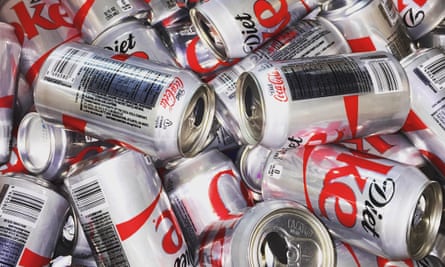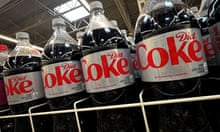A few months ago, I was in a cinema queue behind a man whose two sons were asking if they could have Tango Ice Blasts – bright blue frozen slushy drinks – to go with their tubs of sweet popcorn. The father stalled for a moment. They’d already had too much sugary stuff that day, he said. “But it’s sugar-free,” replied one of the boys. That sealed the deal. The boys walked off happily into the cinema holding their drinks.
In an era when sugar is widely seen as enemy No 1, sugar-free drinks and treats, sweetened with low-calorie additives, promise guilt-free sweetness. Some people deliberately choose low-sugar options in the hope of losing weight or managing diabetes; others just enjoy the taste. But even if you aren’t seeking them out, it’s hard to avoid artificial sweeteners. In 2021, researchers looked at foods for sale in Hong Kong and found that sweeteners were present not just in products where you would expect them, such as sugarless chewing gum, but also in salad dressings, breads, instant noodles and many crisps. Sweeteners have become such a common part of our diet that environmental scientists have started looking for traces of them – particularly acesulfame potassium, which passes through the body largely undigested – as a marker for human waste in lakes and rivers.
The rise of sweeteners is, in part, a sign of the spectacular success of sugar taxes, which have been introduced in more than 40 countries since 2010. In the UK, the soft drinks industry levy was announced in 2016 and fully implemented in 2018, as part of a plan to “tackle childhood obesity”. The tax charged manufacturers 24p a litre for any drink with 8g or more of added sugar per 100ml. Almost all the major soft drinks brands in the UK cut the sugar content of their products and replaced the missing sweetness with some kind of artificial alternative. “Original” Coca-Cola and “blue” Pepsi were among the few drinks to keep their recipes the same. Once they became more expensive, compared to the sugar-free alternatives, their sales fell. By 2019, 60% of all the soft drinks sold by Coca-Cola and 83% of those sold by Pepsi were sugar-free. Today there are even sugar-free “energy drinks” such as Monster Absolutely Zero and Lucozade Zero Pink Lemonade – a puzzling concept, given that sugar is usually what provides the energy in an energy drink.
“Sweeteners” is a catch-all term for a diverse range of chemicals, most of which are far sweeter than sugar, gram for gram, but contain few or no calories. One sweetener approved for use in the US, advantame, is 20,000 times sweeter than sugar. Other sweeteners, such as xylitol, which is commonly used in chewing gum, are comparable in sweetness to sugar.
It’s easy to see why many public health experts might look warmly on these sweeteners as an alternative to sugar. We know that lots of sugar, consumed daily, will increase your risk of type 2 diabetes, heart disease and stroke, not to mention weight gain and tooth decay. As a lover of chocolate brownies and baklava and hundreds of other sweet and lovely things, I wish it were otherwise.
In the light of the many problems with sugar, three central health claims are regularly made for artificial sweeteners. These relate to weight, diabetes and teeth. According to an industry website managed by the International Sweeteners Association, sweeteners are useful for “weight management” (because they contain no calories), for people with diabetes (because they supposedly “have no impact” on blood sugar levels) and for oral health (because unlike sugar, they don’t promote tooth decay).
Public health organisations around the world have largely accepted the sweetener industry’s claims, particularly when it comes to managing diabetes. One article on the NHS website quotes a dietitian who describes sweeteners as “a really useful alternative for people with diabetes who need to watch their blood sugar levels while still enjoying their favourite foods”.
But at just the point when this range of substances have worked their way into so many products, questions are rising as to whether they really have the benefits that have been attributed to them. In July, the World Health Organization (WHO) sowed terror in the diet soft drinks industry by issuing new draft guidelines on “non-sugar sweeteners”. Researchers for the WHO conducted a vast new review of the scientific evidence, examining hundreds of studies on the effects of sweeteners on humans. What they found was startling.
Contrary to the claims so often made for them, the researchers found consistent evidence that consuming a lot of sweeteners was associated with an increased risk of type 2 diabetes (as well as higher risk of heart disease). Similarly, when it came to weight, they found that people who consumed a lot of sweeteners were more likely to gain weight over the long term (though the report also noted that short-term studies, lasting three months or less, showed that switching from sugary drinks to artificially sweetened ones resulted in modest weight loss of 0.71kg).
Even with dental health, the researchers found that the supposed benefits of sweeteners were not conclusive. A couple of studies suggested that daily use of a sweetener called stevia could reduce a child’s risk of getting tooth decay, but in another study, children who consumed more than 250ml of artificially sweetened drinks a day were even more likely to suffer from toothache than those who drank sugary soft drinks or energy drinks, even after adjusting for levels of tooth brushing and economic privilege.
In a startling turnaround, the WHO’s draft guidance stated that non-sugar sweeteners should “not be used as a means of achieving weight control or reducing risk of non-communicable diseases” such as diabetes or heart disease. Suddenly, the whole rationale for sweeteners as a “healthy” alternative looked much shakier. (It remains to be seen how much the final WHO guidance on sweeteners will differ from the draft version. There was a public consultation to offer feedback over the summer, after which the guidelines will be peer-reviewed by an external expert panel. The finalised guidelines will appear in April 2023.)
The Calorie Control Council – a trade group whose members include Coca-Cola and PepsiCo, as well as sweetener giant Cargill – said it was “disappointed” by the WHO draft guidance. It went on to say that sweeteners “have been proven to assist in body weight and blood glucose level management”. But it is those claims – and not just those ones – that are now being questioned.
Someone who has long harboured doubts about the health benefits of artificial sweeteners is Tim Spector, a professor of genetic epidemiology at King’s College London and author of Food For Life: The New Science of Eating Well. Until about 10 years ago, Spector used to drink a lot of Diet Coke. Then he began reading up on sweeteners and was startled to discover that in big population studies, they didn’t seem to be helping people lose weight. This struck him as odd, given their lack of calories.
Spector decided to conduct an experiment, using himself as a guinea pig. When he hooked himself up to a glucose monitor and swallowed a sachet of sucralose – the main ingredient in Splenda, one of the most common sugar substitutes for use in tea and coffee – his blood sugar spiked, as if he had been consuming sugar. “It was not supposed to do that,” Spector said when we spoke on the phone earlier this year. Of course, a single human guinea pig is not the same as peer-reviewed science, and when Spector tried to replicate his findings with colleagues, they did not react to the Splenda in the same way. Spector told me that he had found a frustrating lack of experimental trial data on the effects of sweeteners on human bodies. “Until last Friday!” he exclaimed, with excitement in his voice. He went on to tell me about a paper by Prof Eran Elinav, an immunologist at the Weizmann Institute of Science, south of Tel Aviv, whose work seemed to confirm what Spector had thought but been unable to prove.
A key argument for sweeteners, championed by the industry, is that they are metabolically “inert”. That is, they can deliver the sweetness our mouths crave without affecting the rest of our bodies in any way. However, the new study, which was conducted by Elinav and more than 20 colleagues in Israel, the US and Germany and published in the prestigious scientific journal Cell in August, cast serious doubt on this foundational claim.

In the study, 120 people – all healthy adults who had consumed no sweeteners for the preceding six months – were split into six groups, each of which was assigned a particular sweetener, apart from two control groups, one of which was assigned a sachet of glucose, and a final group that had nothing at all. Twice a day for two weeks, each group consumed a sachet of their assigned material. The study monitored participants’ blood sugar levels and microbes in their stool samples.
The study’s findings were striking. Two sweeteners (aspartame and stevia) were found to have no significant effect on blood sugar. However, the other two (sucralose and saccharin) raised blood sugar in all participants who consumed them. (Within the sucralose group, some participants’ blood sugar levels reacted much more strongly than others, suggesting that physical responses to certain sweeteners may be highly personalised.)
Elinav’s findings on sucralose and saccharin go against decades of public health orthodoxy, which says artificial sweeteners have no effect on blood sugar. What’s more, all four sweeteners tested were found to alter the human microbiome – bacteria in the gut – in ways associated with high blood sugar. These changes were not seen in the control groups. What this tells us, Spector explained, is that none of these sweeteners are “inert” in the human body, as was previously thought. “They do affect our gut microbes, even stevia, which may be the best of a bad lot,” said Spector.
What should we make of these findings? Prof Erik Millstone, who works in science policy research at the University of Sussex and has been studying the effects of sweeteners on human health for nearly 40 years, echoed Spector’s take. He praised the Cell study as providing “overwhelming evidence” that these four sweeteners “are not metabolically inert, as many had previously assumed”. Other experts I spoke to were more cautious. Prof Marion Nestle, professor of nutrition at NYU, told me that the science was “impressive”, but also that she felt we didn’t yet know enough to claim that sweeteners could have a big impact on glucose responses via microbes, given the sheer complexity of the human microbiome. Barry Popkin, distinguished professor of nutrition at UNC in North Carolina, agreed that it was “an important study”, but that he preferred to look at “the full set of studies” on sweeteners rather than focusing on just one.
Elinav’s work is not the first piece of science to suggest that some sweeteners may raise blood sugar. For nearly 20 years, Susan Swithers, professor of neuroscience and behaviour at Purdue University, has been studying the effects of artificial sweeteners on rodents. Her lab has found that rats given artificial sweeteners experience blood sugar spikes, and that they also “eat more of their regular diet, gain extra weight and are fatter than rats given dietary supplements sweetened with a caloric sugar”. In other words, in rats, sweeteners had the opposite effects to what one might expect: they increased blood sugar and seemed to lead to weight gain.
Humans are not rats, and animal studies can only tell us so much about the effect of sweeteners on humans. But such studies are designed to be read in conjunction with the big population studies involving humans, many of which formed the basis of the new WHO draft guidelines. In September, the BMJ published another study of this kind – involving more than 100,000 French adults – which found that artificial sweeteners may be linked with increased risk of heart disease. The results suggest that sweeteners “should not be considered a healthy and safe alternative to sugar”, said the researchers.
Like studies on animals, large-scale observational studies are not in themselves conclusive. By their nature, such studies can only show a correlation between sweeteners and adverse outcomes, rather than proving that sweeteners cause these outcomes. Given that many people turn to sweeteners precisely in order to lose weight, there’s a suspicion that the correlation between high weight and sweeteners may be “reverse causation”: it might look as if sweeteners cause weight gain when really it’s that overweight people are more likely to consume them.
But when it comes to establishing health risks, correlation plus animal studies is often the best we have to go on. In the mid-20th century, the link between tobacco and lung cancer was almost entirely built on these kind of studies. When it came to non-sugar sweeteners, the WHO focused on population studies whose authors had made robust attempts to adjust for confounding factors such as a person’s alcohol intake and levels of physical activity. In the diabetes studies, the authors adjusted for body mass index (BMI) but, overall, people who consumed a lot of sweeteners were found to have an increased risk of diabetes, regardless of their weight.
Why have we been so slow to pick up on the signs that sweeteners are not necessarily as beneficial to health as has been claimed? Prof Alison Sylvetsky, an associate professor in the department of exercise and nutrition sciences at George Washington University, recently told the New Scientist that when it comes to weight management and chronic diseases such as diabetes, there is more and more evidence “that these low-calorie sweeteners may not be helpful and may actually be counterproductive”. But for most of their history, the question of whether artificially sweetened low-calorie drinks really helped with weight loss and blood sugar management was hardly examined. There was a more pressing issue to clear up: did they cause cancer?
The origin story of many of the most famous artificial sweeteners tends to start with a lab experiment gone awry. This pattern was set in 1879 when a chemist called Constantin Fahlberg was working with coal tar derivatives at Johns Hopkins University in the hope of discovering a new food preservative. The legend goes that one day, after finishing a series of experiments, Fahlberg licked his finger and was amazed to discover how sweet it tasted. He started to work in secret to perfect the product, which he named saccharin. When he finally launched it at the World’s Fair in Chicago in 1893, Fahlberg marketed saccharin as a “perfectly harmless spice”, 500 times sweeter than “the best sugar”. The word “spice” cleverly hid the industrial origins of saccharin and the fact that it was made from coal tar: a sticky dark liquid that is a byproduct of burning coal.
Saccharin had a mixed reputation from the beginning. In the early 20th century, it was a byword for cheap and sickening fakery, as opposed to the all-natural properties of sugar, which was not yet seen as a problematic food. In 1908, Harvey Wiley, who was then the head of the US Food and Drug Administration, sought to have saccharin eliminated from the food supply as an impure additive. But President Theodore Roosevelt, who used saccharin after his doctor prescribed him a sugar-free diet, personally intervened to prevent it being banned. In 1977, the FDA once again attempted (and again, failed) to ban saccharin after studies showed that high doses caused bladder cancer in rats.
Saccharin set the pattern for a story that would be repeated several times during the course of the 20th century. A brilliant scientist discovers a new miracle substance many times sweeter than sugar. The substance is introduced into the food supply, only for fears to emerge over its safety, setting the food industry off on another frantic search for the next miracle sweetener. After saccharin, cyclamate was the next wonder-sweetener. It was discovered in the 1930s, became a household staple in the 1950s, and then in 1969 was banned, similarly owing to evidence linking it to bladder cancer in rats.

Then came aspartame, the sweetener that, more than any other, gave rise to the sugar-free foodscape of today. As Carolyn de la Peña explains in her excellent 2010 history of sweeteners, Empty Pleasures, aspartame was the first sweetener that could be used to create diet drinks “with no bitter aftertaste and no calories”. By 2005, it was being used in more than 6,000 food and drink products around the world, including Diet Coke and Diet Pepsi.
Over the past 20 years or more, doubts have circulated about the safety of aspartame, with several studies from the Ramazzini Institute in Italy, published between 2006 and 2010, showing that the substance causes malignant tumours in rats and mice. In 2013, however, the European Food Safety Agency (EFSA) conducted an assessment of aspartame in humans and concluded that it was safe for the general population, including infants, children and pregnant women. The EFSA sets “acceptable daily intakes” or ADIs, which are the maximum amount of sweeteners considered “safe” to consume. In order to exceed the daily limit for aspartame, an adult weighing 60kg would have to consume somewhere between 12 and 36 cans of fizzy diet drink per day.
Some scientists, such as Erik Millstone at the University of Sussex, remain sceptical. When we spoke recently, Millstone argued that lobbying and research funding by the food industry has played a powerful role in downplaying the potential risks of sweeteners, including aspartame, smoothing their path to regulatory approval. A 2016 “review of reviews” noted that “Artificial sweetener industry-sponsored reviews [of the effects of sweeteners] were more likely to have favourable results than non-industry-sponsored reviews” and found that there was a high risk of bias in these studies.
The sweetener industry – which, as of November 2022, was worth $2.1bn globally – spends a fortune on lobbying and PR to reassure consumers that sweeteners are safe. From 2010 to 2015, Coca-Cola donated more than $1.7m to the Calorie Control Council (CCC), a trade body. In 2013, the then president of the CCC wrote to Purdue University to complain about one of Susan Swithers’ review articles, which had laid out the evidence to date that sweeteners may raise the risk of weight gain and diabetes. The CCC demanded that Purdue stop “promoting biased science”. Swithers referred to this as “intimidation tactics” and noted that her paper was peer-reviewed.
Still, it is important to emphasise that after all of the sweetener and cancer scares of the 20th century, there remains little independent evidence that sweeteners are carcinogenic in humans. The new WHO report looked at a total of 48 studies on humans investigating possible links between non-sugar sweeteners and cancer, and found no significant association with cancer, with the possible exception of bladder cancer. (This latter finding was based on what the WHO calls “very low certainty evidence”, so it seems more research is needed.) Contrary to many of the scare stories circulating about sweeteners over the years, the WHO could find no statistically significant links between high diet soda consumption and brain cancer or breast cancer.
But asking whether sweeteners cause cancer is not the only way to determine whether they are “safe”. What makes the new WHO draft guidelines a radical departure is that they do not focus on this or that particular variety of sweetener, and whether it may be carcinogenic. The draft guidelines are far more sweeping. They point out that there are “health effects” – specifically long-term weight gain and an increased risk of type 2 diabetes – associated not just with specific types of sweeteners, but with sweeteners in general. They also note that simply replacing sugar with sweeteners will not improve “the overall quality of the diet”. Instead of switching from sugar to sweeteners, the WHO says it would be better to eat more fruit and “minimally processed unsweetened foods and beverages”. A high-sweetener diet traps people into eating a diet of “highly processed foods and beverages”, a diet that is far from healthy.
In 2019, when Vicky Sibson, a public health nutritionist at the charity First Steps Nutrition Trust, co-authored a report on artificial sweeteners and children’s diets in the UK, she was startled to find that there was no explicit public health messaging telling parents to avoid giving sweeteners to young children. Baby food manufacturers are not allowed to add sweeteners to their products, as they are additives and all additives are banned from foods and drinks for infants. But because children in most households soon eat the same food as the adults, in the absence of advice to the contrary, many children end up consuming sweeteners from a young age.
There is much that we don’t know about the effects of sweeteners on children’s bodies because, as Sibson notes, “the evidence is mostly focused on adults”. But there are signs that some children are adversely affected by sweeteners before they are even born. Meta-analysis from the WHO found that pregnant women who consumed a lot of sweeteners had a 25% higher risk of preterm birth. Meanwhile, in a big study from Canada, children whose mothers drank diet soda every day while pregnant were more than twice as likely to be overweight by the age of one. Although the usual caveats about causation and correlation apply, researchers found that these associations remained, though to a lesser extent, after adjusting for the BMI of the mothers and their diet quality.

One problem with sweeteners in the diet of children, Sibson says, is that the more children consume them, the more they develop a sweet palate and therefore crave sweetness in all its forms, with or without sugar. Research by Allison Sylvetsky in the US found that children and teenagers who drank more diet sodas also ended up consuming more sugar overall than children who drank water.
This is an issue common to all sweeteners. Sibson notes that the very fact that people think sweeteners are not as unhealthy as sugar also makes us consume more of them. Barry Popkin is another nutrition expert who worries about the role of sweeteners in driving “sweetness preference” in young children. Popkin helped push for a new set of labelling laws in Mexico, which came into force in 2020: any food or drink containing sweeteners in Mexico must now carry a black warning sign saying “Contains sweeteners, not recommended for children”. A similar label will soon be required in Colombia.
Every one of the experts I spoke to emphasised that by far the best answer for our health would be for people to get used to a less sweet diet; to learn to quench our thirst with water and unsweetened tea rather than sweetened drinks (whether the sweetness comes from sugar or sweeteners). But sweeteners are no easy thing to give up.
In 1987, Bob Shapiro, who was then the president of NutraSweet, the American company that originally marketed aspartame, noted that one of the “cardinal rules” in western culture was that pleasure always came at a cost. Shapiro added: “What we are saying to people is ‘you can have the pleasure without paying the price’. That’s like saying there is such a thing as a free lunch.”
In the story of modern food, sweeteners have been a “free lunch” both to those who sell them and those who consume them. For the big food companies, they have played a key role in keeping products both profitable and palatable. Not only are sweeteners much cheaper ingredients than sugar, they have also been one of the central mechanisms by which the food industry persuades us to buy and consume more. Most adults only need to eat around 2,000-2,600 calories a day. This is a problem for businesses that want to achieve constant growth. Sweeteners were a way round this – a means by which the multinationals could encourage us to buy more food and drink than we needed, without going over our daily calorie limits.
For millions of people, diet drinks provide coping mechanisms: little moments of guilt-free pleasure to punctuate difficult days. Before she became a historian, Carolyn de la Peña was working in corporate branding for a large soft drinks company in the US. One of De la Peña’s assignments, as she describes in her book Empty Pleasures, was to interview “diet brand X loyalists” – mostly working women – who consumed between six and eight cans of diet fizzy drinks a day. De la Peña found that they all talked about how exhausted they were by their routines, whether it was the demands of childcare or the frustrations of jobs that were boring and low paid. These women “universally characterised the minutes when they consumed a Diet X as distinct from these routines … a little ‘treat’ that they could have without guilt, a brief period of time when the rest of the world would leave them alone”.
In 1977, when the FDA threatened to ban saccharin based on the evidence that it was carcinogenic in rats, it inspired an unprecedented letter-writing campaign from passionate saccharin fans, many of them Weight Watchers members. A million individuals wrote to the FDA protesting the ban. Many of the letters effectively said that they did not care if saccharin gave them cancer so long as it helped them to lose weight. “I must be allowed saccharin or I will die,” wrote one woman in Evansville, Indiana, describing herself as “a fat person who craves sweets”. As for whether saccharin was carcinogenic, another woman, based in Columbus, Ohio, wrote: “let us take our chances”.
But will a million dieters still “take their chances” with diet drinks after hearing the new WHO statement that sweeteners are not actually recommended as “a means of weight control”? Perhaps not – but that would require them to hear about the new research in the first place. Vicky Sibson had hoped the publication of the WHO draft guidelines would be “game-changing”, but her impression is that, so far, the UK government is “completely ignoring it” – in common with most other governments in the world.
And yet, there are small signs of a shift to a less highly sweetened diet. Over the past few years, the soft drinks industry has invested heavily in “seltzers”: sparkling waters that are flavoured but totally unsweetened. Pepsi has launched a seltzer called Bubly and Coke has Aha. Or you can make your own “low-sugar” fizzy drinks for a fraction of the cost by adding a dash of fruit juice to a big glass of sparkling water with or without a slice of lemon or lime. Whether this satisfies the same cravings as Coke Zero or Diet Pepsi is a different question.
Human tastes have a marvellous capacity to change, and it is not impossible to dial down your preference for sweetness, as anyone who has given up sugar in tea discovers. You reach the point where the very thought of sweet tea is unappealing. Then again, sweeteners may be harder to relinquish, given that they are what you have when you are already denying yourself other things. In this gloomy and unequal world, the belief that you can consume sweetness without consequences is one of the last pleasant illusions to which people cling.







